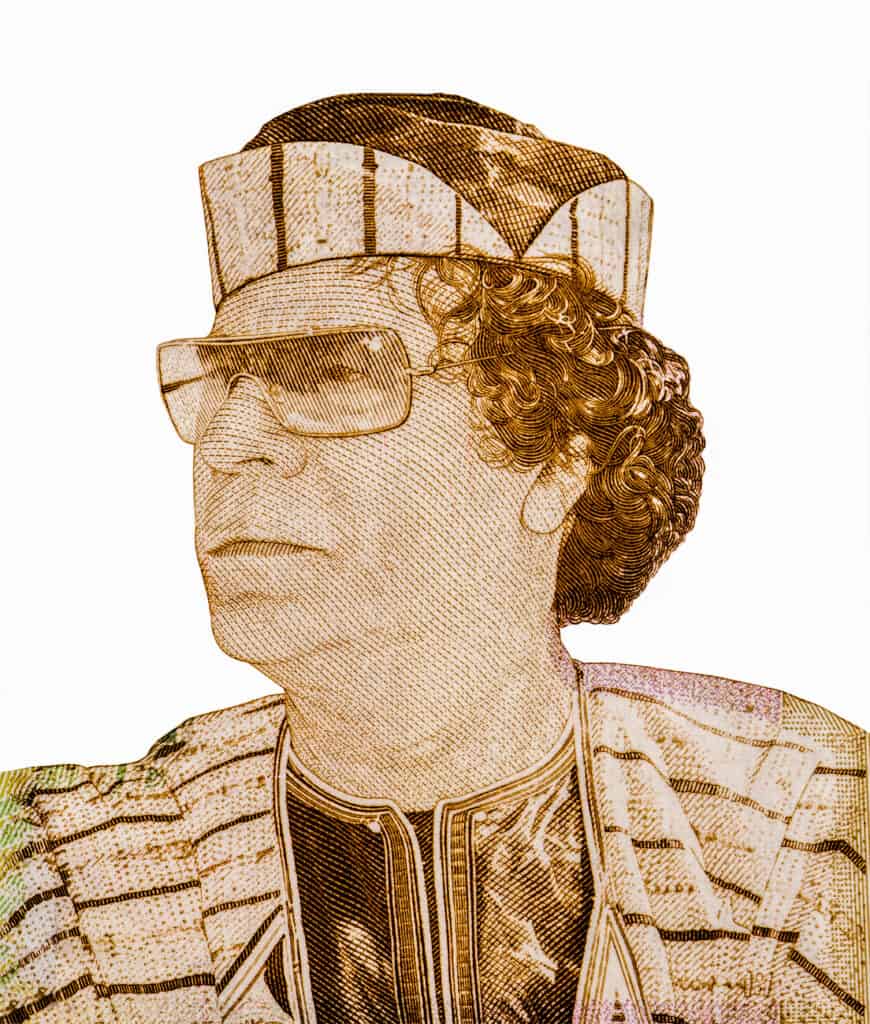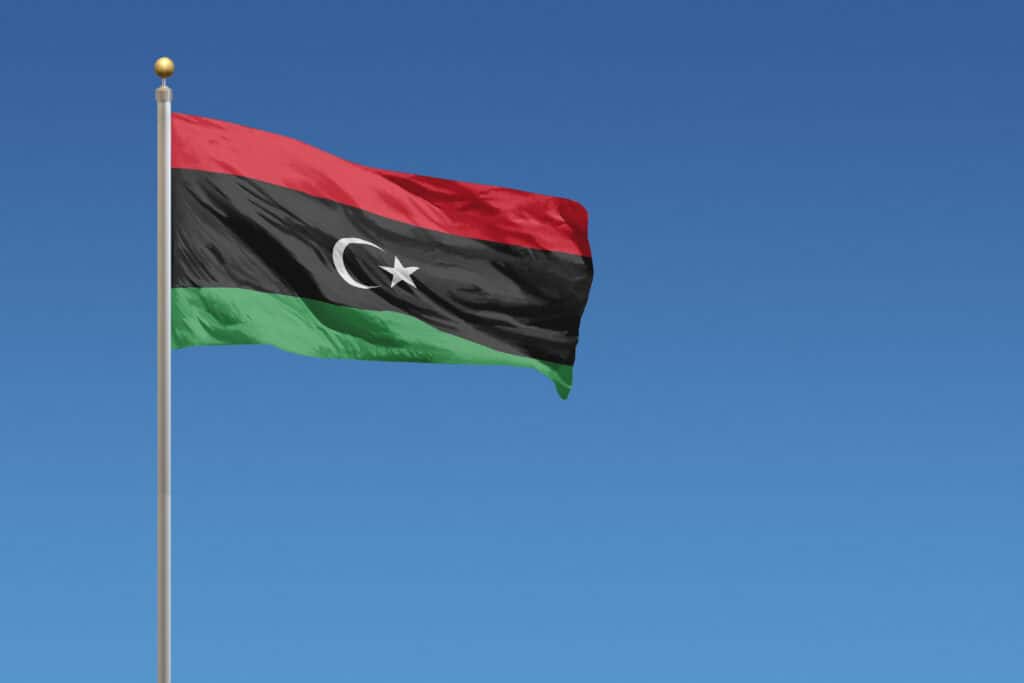Like all Arab nations, Libya‘s flag proudly displays pan-Arab colors. The first three colors—red, black, and green—are in the form of horizontal stripes, although their heights vary. A black five-pointed star and a crescent moon sit in the middle of the flag. The other notable feature of the Libyan flag is its rectangular shape, with its length double that of its height.
Libya’s national flag was initially introduced in 1951 when the Kingdom of Libya was created. The Defense Minister, Faiek Shennib, designed the flag, and King Idris Al Senussi approved it. Idris was part of a UN delegation representing Cyrenaica, Fezzan, and Tripolitania regions at unification discussions.
After the Col. Muammar Qaddafi coup, Libya abandoned the flag in 1969. The current version consists of a triband design with red at the top, black in the center, and green at the bottom. Additionally, the flag has a white crescent and star at its center.
Today, we delve into the Libyan flag’s history, meaning, and symbolism.
History of the Flag
Libya’s national flag has seen many twists and turns. Italy colonized Libya from 1911 to 1942. During this time, the country did not have a flag. When the French and the British took over between 1943 and 1951, these governments only flew the French Tricolor flag and the Union Jack flag. Libya adapted the current flag after the country’s independence in 1951.
Senussi Dynasty Flag (Before 1864)
The Senussi Dynasty occupied the east of what is now Libya for many years. The powerful dynasty, also known as the Senussiya, had long flown a black banner inscribed with Quran teachings.
The first flag of Libya was based on this banner. It featured a black field with a star and crescent.
The Ottoman Tripolitani, Kingdom of Tripoli Flag (1864 and 1911)
The Kingdom of Tripoli was a semi-autonomous Ottoman Empire province. The empire allowed the kingdom to hang the flag of its royal family. This flag lasted between 1864 and 1911, before Italy captured the region. The flag featured a green field that echoed the Fatimid caliphate. In addition, three white crescent moons—noticeable Islamic symbols—sat at the flag’s center.
The Tripolitanian Republic Flag (1918 to 1949)
This flag was adopted in 1918 following the collapse of the Ottoman Empire. The Kingdom of Libya was set to take over the entirety of Libya, but some regions resisted.
Those in Tripolitania broke away from the kingdom and formed the Tripolitanian Republic, Libya’s first-ever modern republic.
The Tripolitanian Republic’s flag resembled the current flag of Somalia. It had a blue background inscribed with a white five-pointed star at the top. Additionally, it had a striking, big, green palm tree, believed to refer to the Fatimids and the Libyan coast known for its blue seas, starry skies, and green trees.
The United Kingdom of Libya Flag (1949 to 1951)
When Idris Al Senussi became the emir of Cyrenaica in 1947, he endeavored to merge Cyrenaica with Fezzan and Tripolitania to form the United Kingdom of Libya. At the time, Cyrenaica’s black flag with a white crescent and star wasn’t accepted as Libya’s national flag. However, when the merger was successful, Idris became the King of Libya.
When the Libyan national flag was designed in 1949, red and green horizontal stripes were included to represent Fezzan and Tripolitania, respectively.
No changes were made to the flag when Libya gained its independence in 1951.
The Libyan Arab Republic Flag (1969 to1972)
The United Kingdom of Libya under King Idris Al Senussi did not work out well in the end. Like most formerly colonized nations, there was a lot of meddling in the kingdom’s government. Although King Idris had genuine support, his political position was weak.
In 1969, Libya fell to a bloodless military coup while the king was out of the country. The coup was led by Col. Muammar Gaddafi, an idealist who wanted to follow in Nasser’s footsteps of building pan-Arab unity. Gaddafi introduced a flag with red, white, and black horizontal stripes to imitate the Arab Liberation Flag. The same flag flew unofficially in Egypt. The Arab Liberation Flag also influenced the design of Egypt’s current national flag.
Libya’s flag during this time wasn’t really a flag for Libya. It was the Arab Liberation Flag Nasser used in the 1952 Egyptian Revolution.
The flag’s colors evoked Islamic caliphates’ historical banners. Black was for Muhammad, red represented Hashemite, green was for Fatimid, and white was for Umayyad. The green color wasn’t on the Arab Liberation Flag because the Fatimid caliphate was Shia and not Sunni, which heavily influenced Egyptian liberation. Besides, green had little connection with the historical state of Egypt.
The flag would soon spread to other pan-Arab-minded revolutionary governments.

In 1969, Libya fell to a bloodless military coup led by Col. Muammar Gaddafi, an idealist who wanted to build a pan-Arab unity.
©Prachaya Roekdeethaweesab/Shutterstock.com
The Federation of Arab Republics Flag (1972 to 1977)
By 1972, Gaddafi was ready to put his pan-Arab ideology into practice. He had with him just the allies he needed. The flag of Libya once again changed as Syria and Egypt united to kick-start the pan-Arab era through the Federation of Arab Republics.
But this move didn’t accomplish much. Within a year, the member countries’ relations deteriorated after Egypt recognized Israel and normalized its relations with the US. The new political union remained more on paper than in reality, although the countries shared a flag.
The Socialist People’s Libyan Arab Jamahiriya Flag (1977 to 2011)
Gaddafi would later break Libya’s diplomatic relations with neighboring Egypt when Anwar Sadat, Egypt’s then-president, brokered a peace deal with Israel. Consequently, Qaddafi changed Libya’s national flag to express his displeasure at Sadat’s disloyalty to anti-Israel Arab states.
In November 1977, Qaddafi launched a plain green flag to symbolize the “Green Revolution,” which he promised would usher in a new life for all Libyans.
It’s worth noting that Libya had once been a place of rich farmland under the Roman Empire. But increasing desertification had impoverished this land. Gaddafi’s “Green Revolution” aimed to find a sufficient water supply and other resources to make Libya green and prosperous again. Besides, green symbolized Islam.
The Current Flag of Libya (2011 to Present Day)
Gaddafi was overthrown in 2011, following the Arab Spring uprising that engulfed most Arab states.
Following Gaddafi’s death, the new government, formed by the National Transitional Council, immediately reinstated the 1949 flag.
In March 2011, France led the world in recognizing the council as Libya’s official government. France also became the first to allow Libya’s staff to raise their flag on French soil. Later in March, Libya’s Permanent Mission to the UN flew the flag and it appeared on the nation’s official website.
In August, the Arab League officially recognized the flag, and the country’s telecommunication authority, Libya Telecom & Technology, published it on its website. In the ensuing months, more Libyan embassies replaced Qaddafi’s flag with the tricolor version.
Currently, the tricolor flag is the only one that the UN uses to represent Libya. Additionally, all the country’s consulates and embassies use this flag.

Following Gaddafi’s death, the new government, formed by the National Transitional Council, immediately reinstated the 1949 flag.
©Derek Brumby/Shutterstock.com
Meaning of the Libyan Flag
As noted above, the current flag of Libya has a red band at the top, while a green one of equal size is located at its bottom. The center of the flag is a double-height black band.
So, what do the colors of the Libyan flag mean?
In Libya, the flag’s colors have a more precise meaning: they reflect the country’s territory and history. The stripes represent Libya’s three main provinces—Tripolitania, Cyrenaica, and Fezzan.
For Arab countries such as Libya, white represents peace, while black means battle. Green symbolizes the pastures as well as Islam, while red represents the sword.
The red color pays tribute to the martyrs of the battles that took place between 1912 and 1943 when Libya was under Italian rule.
As for the black, it evokes the standard of the Senussi (a powerful Muslim brotherhood of Libyan origin). Additionally, the black flag that Prophet Muhammad carried inspired the black background.
The Symbolism of the Flag of Libya
The Hawk of Quraish is a popular pan-Arab symbol, which originated in Syria between 1950 and 1963.
Hawkery or falconry is a popular traditional pastime in many Arab world nations. There are claims that the tribes under Prophet Muhammad used the symbol as well.
A white five-pointed star and a white crescent moon are in the center of the Libyan flag. The star symbolizes hope and the end of darkness in Libya, while the crescent symbolizes the beginning of the Muslim lunar month.
Moreover, the crescent and star symbolize Islam, the main religion in Libya and other Arab nations.
Up next:
- Animals in Libya
- 10 Countries With Blue and White Flags, All Listed
- 29 Different Countries with Red, White, and Blue Flags
- 6 Countries With Blue and Yellow Flags, All Listed
The photo featured at the top of this post is © BOLDG/Shutterstock.com
Sources
- Wikipedia, Available here: https://en.wikipedia.org
- (1970)
Thank you for reading! Have some feedback for us? Contact the AZ Animals editorial team.






